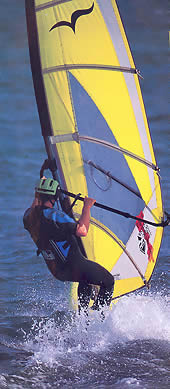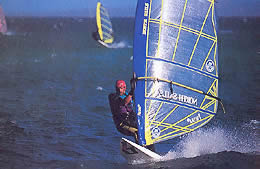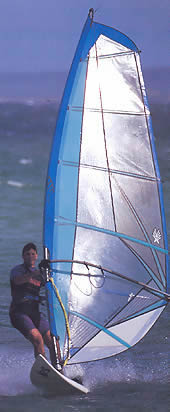|
Windsurfers: The Hunters of the Wind
By: Alfredo Martínez Fernández
Wind, of course, is required for practicing the exciting sport of windsurfing. Enthusiasts wander around the world in search of the best winds, be they on lakes, on the sea or on rivers. There are many places in both the north and south hemispheres where one can windsurf. Some have extreme winds that are only for experts; however, the most popular are located within the Topics of Cancer and Capricorn where the climactic factors of wind, the movement of the sea etc are ideal. Some of the best places for practicing this sport are Aruba, Antigua, Barbados, Curacao in the Antilles islands; Hawaii, Maui and Kauai in the Pacific Ocean; the Canary islands in Spain and Cancun and Baja California in Mexico. In fact, anywhere you choose to practice this sport –the giant waves that beat down on the coast of Hawaii, or the speeds reached as you ride the waters of the mythical Sea of Cortés and the beautiful seas in Southern Baja California where you can also admire a wide assortment of flora and fauna – you will be presented with an exciting challenge. Strong north winds blow from the end of November through the middle of February in this region of the country, and East Cabo becomes a favorite destination for thrills and adventure among national and foreign windsurfers. We packed all our gear onto our 4 x 4 vehicle, including camping gear, windsurfer boards, masts, booms, harnesses and neoprene wet suits, and set off to have some fun. We left La Paz where our goof friend and instructor, Kim Glover, had taught us some of the windsurfing basics, which surprisingly took us less time to master than we had thought. He taught us steering, understanding the direction of the wind, and after a while, we started doing some of the more difficult maneuvers such as turns, water-starts, and taking off from the water. However, the question was, were we ready to face the challenges of the North wind.
We steered the windsurfer by standing on the aft part of the board; this pushed the nose of the board upwards and allowed it to cut through the choppy waters of the Sea of Cortés. While dealing with this aspect, we also had to control the sail by means of the boom, to which we were attached by the harness. Looking up, I saw the colors of the sail in deep contrast with the blue skies, and heard the wind blowing and whistling around the sail. Windsurfing and everything it entails, including coordinating our maneuvers, keeping balance, especially during the strong bursts of wind and the ever-changing size of the waves, is a most satisfying experience. When the surface of the water is as flat as a mirror with areas of foam and regular-sized waves, or “whitecaps” on the top, that means that the wind is strong and constant; when the sea is very choppy and the waves are high, the experts start showing what they are made of by jumping and doing loops; this involves using the wave as a sort of ramp and jumping, sometimes up to five meters in the air and doing what is know as a loop, or a 360º turn in the air. This can only be done when the wind is blowing at speeds exceeding 30 knots or about 72 km/hour. One type of windsurfing that combines the three disciplines of skiing, surfing, and sailing. It is known as boardsailing and is a pleasure to watch anywhere in the world.
The factors that make Baja California an ideal place for windsurfing are the beaches, the fact that the water is not too cold, -though one has to wear a wetsuit- and the constancy of the wind, though at times it is much gustier than others. These factors mean that one can windsurf there daily. Of course, the northers during the winter months are also very important. The wind changes during the course of the day; in the mornings, it blows onshore at a rate of between 18 and 25 knots. It die down after a few hours, only to return revitalized to produce a force of between 25 and 30 knots in the afternoon; these winds blow in a direction parallel to the beach. Year after years, “hunters of wind” come to southern Baja California to camp along the coast, on the beaches on the cliff tops, in the trailer parks and in the clubs and hotels in the towns of Buena Vista, Los Barriles and la Ribera. Windsurfers do not only get to practice their favorite sport. Some of us have had the unforgettable experience of seeing dolphins, whales and even stingrays jumping in the water, but as lovers of nature, we enjoy being close to the wind, the waves, the sand and the sea. For this very reason, we treat all of these gems of nature and its inhabitants with the utmost respect. Source: México desconocido # 247 / September 1997
Try
the windsurf in Los Cabos, one of many watersports and activities that
you can practice in Los Cabos, Cabo San Lucas and San Jose del Cabo.
Mexico, Los Cabos, sun, sunbathing, watersports, Cabo San Lucas, San
Jose del Cabo, Baja Peninsula, sea, ocean, fishing. los cabos travel
guide, travel services, beach activities, baja california sur mexico,
beaches, adventure, wind, sports, Windsurf, vela,surf,flysurf,fly-surf,
World Windsurfing, Kitesurfing Directory,windsurfing,kitesurfing, sailing,
boards, sail, beach.
|
 Year
after year, the beaches of southern Baja California fill with windsurfers
who either set up camp on the beach or up on the cliff tops.
Year
after year, the beaches of southern Baja California fill with windsurfers
who either set up camp on the beach or up on the cliff tops.  Our
first attempts were a complete failure! We could not get up onto the
board and the sail kept on falling on us, but we did not give up! We
finally caught a spurt of wind and, hanging from the harness, we pulled
the wind-filled sail from one side to the other.
Our
first attempts were a complete failure! We could not get up onto the
board and the sail kept on falling on us, but we did not give up! We
finally caught a spurt of wind and, hanging from the harness, we pulled
the wind-filled sail from one side to the other. Our
adventure along the coast of southern Baja California, between La Paz
and Los Cabos took us to several beautiful beaches, including La Ventana,
Punta Chivatito –a great place for sailing- Palma de Cortés,
Playa Hermosa, Buenavista and Playa de los Barriles. The latter got
its name because a group of explorers supposedly buried barrels full
of gold and other treasure under the riverbed.
Our
adventure along the coast of southern Baja California, between La Paz
and Los Cabos took us to several beautiful beaches, including La Ventana,
Punta Chivatito –a great place for sailing- Palma de Cortés,
Playa Hermosa, Buenavista and Playa de los Barriles. The latter got
its name because a group of explorers supposedly buried barrels full
of gold and other treasure under the riverbed.